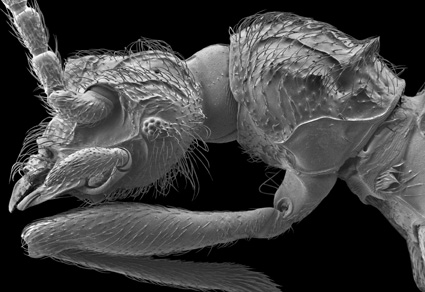Abstract
Tribasodes kamedai Nomura, 2012 was described based on specimens collected in a limestone cave in Okinawa-jima Island. We demonstrate that this species is not a strict troglobite, but presumably a trogloxene, as it was recently collected in new localities from forest leaf litter and hollow trees. Tribasodes kamedai is redescribed in detail, with the first illustrations of female genitalia, notes on interspecific variability, and new distributional records.
References
- Jałoszyński, P. (2023) A new species of Arthromelodes Jeannel from Okinawa-jima, Japan (Coleoptera, Staphylinidae, Pselaphinae). Zootaxa, 5325 (3), 393‒408. https://doi.org/10.11646/zootaxa.5325.3.4
- Jałoszyński, P. & Nomura, S. (2021) A new species of Leptoplectus Casey from Ryukyu Islands, Japan, with comments on morphology of integumental structures in Euplectitae (Coleoptera, Staphylinidae, Pselaphinae). Zootaxa, 4915 (3), 411‒423. https://doi.org/10.11646/zootaxa.4915.3.9
- Jeannel, R. (1958) Révision des Psélaphides du Japon. Mémoires du Muséum national d’Histoire naturelle, Paris, Series A, 18, 1‒138.
- Jeannel, R. (1960) Sur les Psélaphides (Coleoptera) de l’Inde septentrionale. Bulletin of the British Museum (Natural History), Entomology, 9 (9), 401‒456. https://doi.org/10.5962/bhl.part.27558
- Nomura, S. (2012) A new cavernicolous species of the tribe Batrisini (Coleoptera, Staphylinidae, Pselaphinae) from the Ryukyus, southwest Japan. Bulletin of the National Museum of Nature and Science, Series A, 38 (1), 13‒19.
- Sharp, D. (1883) Revision of the Pselaphidae of Japan. Transactions of the Entomological Society of London, 3, 291‒331. https://doi.org/10.1111/j.1365-2311.1883.tb02948.x
- Sket, B. (2008) Can we agree on an ecological classification of subterranean animals? Journal of Natural History, 42 (21‒22), 1549‒1563. https://doi.org/10.1080/00222930801995762
- Yin, Z.-W. (2020) New species of karst-dwelling Pselaphinae from southwestern China (Coleoptera: Staphylinidae). Acta entomologica Musei Nationalis Pragae, 60 (1), 163‒168. https://doi.org/10.37520/aemnp.2020.009
- Yin, Z.-W. & He, L. (2020) New cavernicolous Pselaphinae from Sichuan, China (Coleoptera: Staphylinidae). The Coleopterists Bulletin, 74 (4), 827‒836. https://doi.org/10.1649/0010-065X-74.4.827
- Zhao, M.-J., Yin, Z.-W. & Li, L.-Z. (2010) Two new species of the subtribe Batrisina (Coleoptera, Staphylinidae, Pselaphinae) associated with Pachycondyla luteipes (Formicidae) in China. Sociobiology, 56 (2), 527‒535.


